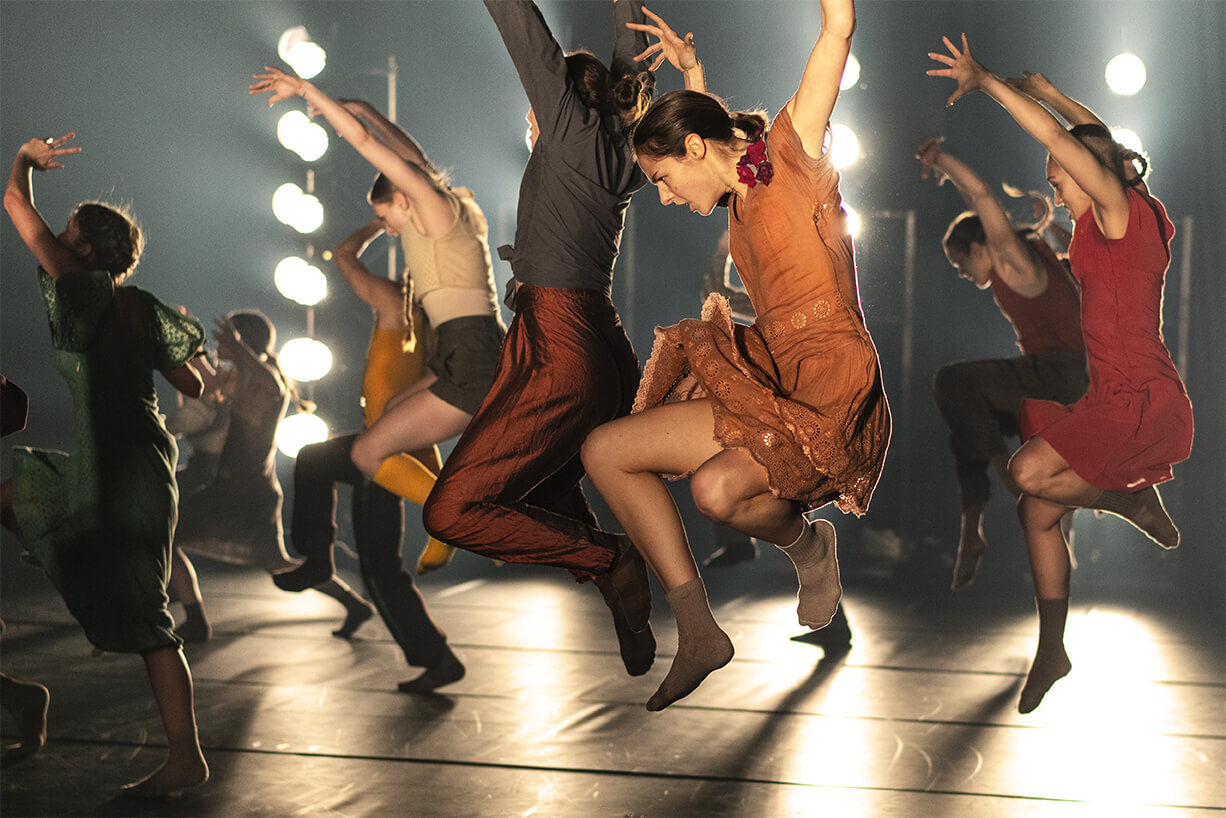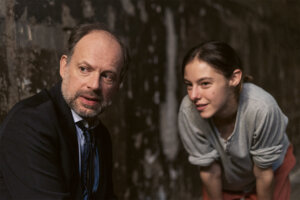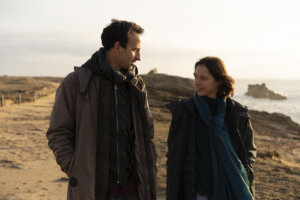Inspired by his grandparents’ tragic Holocaust story, a director imbues his latest hit film with passion and joy
Cédric Klapisch’s ‘Rise’ is the antithesis of Darren Aronofsky’s ‘Black Swan’

Graphic by Angelie Zaslavsky
Cédric Klapisch didn’t want to make another Black Swan. The French director and screenwriter has long wanted to create a fictional dance movie. But against a backdrop of examples that highlight — or lowlight — pain and suffering, his would do something different. It would focus instead on the passion and joy and life that dance offers, albeit not without obstacles — a deliberate choice with roots in his Jewish family’s Holocaust history and his longstanding love for movement.
En Corps, one of the highest–grossing French movies of 2022, is being released in America with the title Rise — an apt hint at the emotional arc that sets this movie apart from the damaged heroines and darker depictions of dance we’ve seen not only in Darren Aronofsky’s iconic 2010 psychological thriller, but also in TV series like Flesh and Bone (2015) and Tiny Pretty Things (2020). The feature-length movie — a partnership between Klapisch and London-based Israeli choreographer Hofesh Shechter who appears as himself — centers real dancers really dancing. There are no body doubles and no illusions.
“People ask me about my work, and I don’t really care about how it looks and how it sounds and all this. It’s really about people,” Shechter told me on a joint Zoom call with Klapisch. It’s “about the human experience and how it feels inside.” He saw something similarly human in Klapisch’s work way back when he watched the director’s 2002 film The Spanish Apartment and he says it made for a harmonious collaboration in Rise. “We really connect in the way that the story is told and where the human emotions are the center of it.”
The first 15 minutes of Rise are almost entirely wordless. We meet our protagonist — 26-year-old Elise Gautier played by Paris Opéra Ballet member Marion Barbeau — standing onstage behind a heavy curtain. Dancers amble and stretch in the dark around Elise, lost in thought as she prepares to make her debut in the 19th-century classic La Bayadere (which, it should be noted, has been increasingly recognized as problematic, not least for its reductive Orientalism). The orchestra is tuning up and audiences filter into the bright, gilded theater. Elise looks through a peephole at the center of the curtain, eyeing three empty seats. Her eyes crinkle with a smile when she sees her father and sisters arrive. She kisses her boyfriend and heads backstage to finish preparing.
All seems to be going as planned for her big moment when she arrives in the wings — that is, until she sees her boyfriend on the opposite side of the stage, cavorting with another dancer. The ballet unfolds between them, a vivid fantasy separating Elise from an untimely betrayal. Her eyes flash with confusion. She shudders as she makes her entrance. For a moment, it’s unclear whether she’ll manage to go on, but then her muscle memory takes over until the virtuosic coda when a jump ends in disaster: She lands in a crumpled heap, clutching her ankle in agony.
Barely any words have been uttered, but we don’t need them. “It was really an intuition that the beginning of the movie had to be like that,” Klapisch said.
“I thought that it was interesting to give to the audience the guidebook or the language,” he added. “They just have to watch. They have to watch dance, they have to watch people, they have to watch the image.” It’s another way of entering the movie and story that Klapisch compares to silent film.
“When you watch a Chaplin movie, everyone understands it. Everyone can enjoy it,” he said.
The same is true of Rise, a movie at once hyperspecific to the life of a dancer and also universal to any human, every human, who’s been dealt an unexpected hand and called upon to tap into their resilience and find another path forward.
American modern dance pioneer Martha Graham famously observed that “a dancer dies twice — once when they stop dancing, and this first death is the more painful.”

For Elise, it seems to arrive far too early. The doctor’s assessment following her fall is devastating: This ankle injury may prevent her from dancing for a year or two. Or quite possibly forever. Like most dancers and elite athletes, she’s dedicated her life from a young age to a consuming physical pursuit that, even in the best-case scenario, is fleeting. Now, she must grapple with an abrupt and early end to that path, identity, and one of few remaining threads that tie her to the mother she lost years ago.
She reconnects with an old friend whose boyfriend is leaving for a gig cooking at an artists’ residency in Brittany and needs some help. By the sheer magic of coincidence, Hofesh Shechter and his contemporary dance company arrive at the idyllic space soon afterward. With some gentle nudges from the residency director, Josiane, who watches Elise watching the dancers, this now-former ballerina opens herself up to discovering a new way to dance.
At first, she replaces a chair. One of Hofesh’s dancers is trying to rehearse a section of choreography where he sits and drags another dancer, limp in his arms, backwards across the floor. Alone in the studio, he uses a chair, maneuvering it around himself and crashing it loudly onto the ground. Josiane snaps that he’ll ruin her furniture, and sends Elise in instead. “It’s simple. You’re supposed to be dead,” the dancer tells Elise. “Can you just stare into space?” he adds. “I’ll make you dance. Just follow.” In this moment of pretend death, her body slack against his, Elise begins to come back to life.
In a wordless scene that follows, Elise joins the dancers on a walk to the sea that turns into a breathtaking improvisation with the wind. They lean into and against it, let it send them stumbling sideways, hold hands, laugh.
“Dance in a way is the opposite of words,” Shechter told me.
“Words simplify everything, but I find them less accurate. And dance complicates things, but it’s more accurate to what my reality is. The way we feel is complicated and sophisticated and very hard to put into words,” he said. “Dance comes from the gut, and then it hits people in the gut.”
By forgoing words at key moments, Rise lets dance do the talking — or rather, lets dance express more than talking could. “Through understanding how to watch dance, which is really about just listening, and just being way less in your head and more in the gut and in the experience, I think it’s a huge part of what makes the film really special,” Shechter said. “It’s like Cédric said, giving them the tools to understand how to connect to dance, that it’s not something that you are going to analyze and understand,” he added. “You sit and you’re just kind of bathing in it. And that’s fine. And that’s enough.”

The one-on-one rehearsal, the dance with the wind, and a conversation with Hofesh on the walk back from the sea convince Elise that she can dance without striving for perfection — so often the aspiration of classical training. She can use weakness and fear to find beauty and joy. And that’s enough to bring her back into the studio in earnest.
“There is something about perseverance that I’m really moved by in dance,” Shechter said. “There is something where, despite the difficulties, despite the loss of hope and the despair, there’s something about dance that just manufactures this feeling of hope and forward momentum,” he said. “There is the euphoric feeling when you’re moving.”
Not every viewer will understand the particular experience of a dancer’s first death arriving far too soon. But everyone has been diverted from their path, blown off course, punched in the face in ways large and small. Like Elise’s father, who’s been emotionally distant from his three daughters since their mother’s death and for most of the movie continues to let opportunities to connect pass them by rather than truly seeing his girls, telling them he loves them, and forging deeper relationships. Like all the dancers and actors and creators behind the film, who were sidelined when COVID hit. Like me, watching the film in the days after I was unexpectedly laid off from a job of more than five years. The question is: What do we do next? Do we, as Elise recalls her mother telling her, “make the most of all the lives that life offers you”?
“In France, at the beginning, it was really dance fans who went to see the movie. And by the end, it was more people who didn’t know dance or dislike dance,” said Klapisch who recognizes that Rise both is and isn’t about the art form. “It’s funny how people understand that it’s not talking about dance, it’s talking about something else, and it can relate to other people.”
As the American title of the film suggests, “It’s really about rebirth or something that’s uplifting,” Klapisch explained. “It is about optimism.”
That’s something the world desperately needed when Klapisch was writing and making the film in 2020, during the early months of the pandemic lockdowns. While he was making a short video with the Paris Opéra Ballet in April 2020, he’d discovered that “when you’re locked down, when you’re in jail, dance is like opening the window.” As lockdowns dragged on, he remembered, people in France talked about being in a tunnel they couldn’t see the end of. But of course, “it ended, and we are out of the tunnel now.”
Nearly a decade ago, when Klapisch’s movie Chinese Puzzle came out, he said in an interview with the Forward that he almost felt a duty to be happy. In part, that impetus came from the fact that his maternal grandparents, who died in Auschwitz, could not.
“I agree with me,” Klapisch joked, listening to me read his words back to him years later. But on a more serious note, “My grandparents died during the war and like a lot of Jewish people I have that with me,” he said. “And unlike my parents — my father and my mother, who were children during the war and probably it was a very heavy, how you call that, heavy luggage to carry — for me, I wanted to experience lightness, something like that, because of that heaviness.”
It’s not surprising, then, that Klapisch was driven to create a movie so far afield from Black Swan. Because for him, “Dance is really about life. It’s a metaphor of life, and it’s a metaphor of people who want to enjoy life.”
And if it feels a little trite and naive for me to write about the inspiring optimism of Rise as I have in an era that tends to mock earnestness, I’ll just remember that, as Shechter put it, words fail us sometimes. It’s a little more complicated than that, if you’d just watch, listen, and let this dancing hit you right in the gut.






















